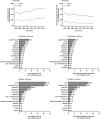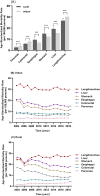Trends in cancer mortality in China from 2004 to 2018: A nationwide longitudinal study
- PMID: 34251754
- PMCID: PMC8504142
- DOI: 10.1002/cac2.12195
Trends in cancer mortality in China from 2004 to 2018: A nationwide longitudinal study
Abstract
Background: The long-term trend in cancer death in a rapidly developing country provides information for cancer prophylaxis. Here, we aimed to identify the trends in cancer mortality in China during the 2004-2018 period.
Methods: Using raw data from the national mortality surveillance system of China, we assessed the mortalities of all cancer and site-specific cancers during the 2004-2018 period. The participants were divided into three age groups: ≥65 years, 40-64 years, and ≤39 years. Changing trends in cancer death by gender, residency, and tumor location were estimated using fitting joinpoint models to log-transformed crude mortality rates (CMRs) and age-standardized mortality rates (ASMRs).
Results: Cancer death accounted for 24% of all-cause of death in China during 2014-2018. The CMR of all cancer was 150.0 per 100,000 persons. Cancer was the leading cause of death in the population <65 years. The six major cancer types (lung/bronchus cancer, liver cancer, stomach cancer, esophagus cancer, colorectal cancer, and pancreas cancer) accounted for 75.85% of all cancer deaths. The CMR of all cancer increased while the ASMR decreased during 2014-2018 (P < 0.001). Lung/bronchus cancer and liver cancer were the leading causes of cancer death in the population <65 years, accounting for 45.31% (CMR) and 44.35% (ASMR) of all cancer death, respectively. The ASMR of liver cancer was higher in the 40-64 years population than in the ≥65 years population, in contrast to the other five major cancers. The ASMRs of liver cancer, stomach cancer, and esophagus cancer decreased although they were higher in rural residents than in urban residents; the ASMRs of lung/bronchus cancer, colorectal cancer, and pancreas cancer increased in rural residents although they were higher in urban residents than in rural residents during 2014-2018.
Conclusion: Although the ASMR of all cancer decreased in China during 2004-2018, lung/bronchus cancer and liver cancer remained the leading causes of cancer-related premature death. Lung/bronchus cancer, colorectal cancer, and pancreas cancer increased in rural residents.
Keywords: age-standardized mortality rate; breast cancer; colorectal cancer; crude mortality rate; demographic distribution; liver cancer; national mortality surveillance system; premature death; site-specific cancer; stomach cancer; trend.
© 2021 The Authors. Cancer Communications published by John Wiley & Sons Australia, Ltd. on behalf of Sun Yat-sen University Cancer Center.
Conflict of interest statement
The authors declare no conflicts of interest.
Figures





References
-
- Bray F, Laversanne M, Weiderpass E, Soerjomataram I. The ever‐increasing importance of cancer as a leading cause of premature death worldwide. Cancer. 2021. - PubMed
-
- Sung H, Ferlay J, Siegel RL, Laversanne M, Soerjomataram I, Jemal A, et al. Global Cancer Statistics 2020: GLOBOCAN Estimates of Incidence and Mortality Worldwide for 36 Cancers in 185 Countries. CA Cancer J Clin. 2021;71(3):209–49. - PubMed
Publication types
MeSH terms
Grants and funding
LinkOut - more resources
Full Text Sources
Medical

